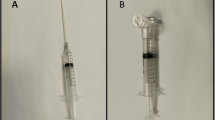Abstract
OBJECTIVE: Determine whether end-tidal CO2 (ETCO2) monitoring allows for more rapid discrimination of tracheal versus esophageal intubation than standard clinical assessment during neonatal resuscitation in the delivery room.
STUDY DESIGN: Endotracheal tube (ETT) placement was assessed using either a hand-held monitor that displayed graphic and quantitative ETCO 2 by an investigator not involved in the resuscitation, or using clinical parameters by the resuscitation team unaware of the ETCO 2 data. The time differences between ETCO 2 and clinical determinations of ETT placement were compared.
RESULTS: Capnography correctly identified all 16 tracheal and 11 esophageal intubations performed on 16 study infants. The median times (and range) in seconds required for capnographic and clinical determination of tracheal intubation were 9 (4 to 26) vs. 35 (18 to 70), p<.001, and for esophageal intubation were 9 (4 to 17) vs. 30 (25 to 111), p=.001.
CONCLUSION: Capnography allowed more rapid determination of both tracheal and unintended esophageal intubation than clinical assessment.
This is a preview of subscription content, access via your institution
Access options
Subscribe to this journal
Receive 12 print issues and online access
$259.00 per year
only $21.58 per issue
Buy this article
- Purchase on Springer Link
- Instant access to full article PDF
Prices may be subject to local taxes which are calculated during checkout
Similar content being viewed by others
References
Birmingham PK, Cheney FW, Ward RJ Esophageal intubation: a review of detection techniques Anesth Analg 1986 65 886–891
Pollard BJ, Junius F Accidental intubation of the esophagus Anaesth Intensive Care 1980 8 183–186
Utting JE, Gray TC, Shelley FC Human misadventure in anaesthesia Can Anaesth Soc J 1979 26 472–478
Stewart RD, Paris PM, Winter PM, et al Field endotracheal intubation by paramedical personnel: success rates and complications Chest 1984 85 341–345
Howells TH, Riethmuller RJ Signs of endotracheal intubation Anaesthesia 1980 35 984–986
Roberts WA, Maniscalco WM, Cohen AR, et al The use of capnography for recognition of esophageal intubation in the neonatal intensive care unit Pediatr Pulmonol 1995 19 262–268
Bhende MS, Thompson AE, Orr RA Utility of an end-tidal carbon dioxide detector during stabilization and transport of critically ill children Pediatrics 1992 89 (6) 1042–1044
Bhende MS, Thompson AE Evaluation of an end-tidal CO 2 detector during pediatric cardiopulmonary resuscitation Pediatrics 1995 95 (3) 395–398
Cheney FW, Posner K, Caplan RA, Ward RJ Standard of care and anesthesia liability JAMA, J Am Med Assoc 1989 261 1599–1603
Utting JE Pitfalls in anaesthetic practice Br J Anaesth 1987 59 877–890
Swedlow DB Capnometry and capnography: the anesthesia disaster early warning system Semin Anesth 1986 3 194–205
Linko K, Paloheimo M, Tammisto T Capnography for detection of accidental oesophageal intubation Acta Anaesthesiol Scand 1983 27 199–202
Acknowledgements
Funded by the Children's Miracle Network Telethon and the Eudowood Foundation.
Author information
Authors and Affiliations
Rights and permissions
About this article
Cite this article
Repetto, J., Donohue, PA-C, P., Baker, S. et al. Use of Capnography in the Delivery Room for Assessment of Endotracheal Tube Placement. J Perinatol 21, 284–287 (2001). https://doi.org/10.1038/sj.jp.7210534
Published:
Issue Date:
DOI: https://doi.org/10.1038/sj.jp.7210534
This article is cited by
-
Non-invasive carbon dioxide monitoring in neonates: methods, benefits, and pitfalls
Journal of Perinatology (2021)
-
Assessment of endotracheal tube placement in newborn infants: a randomized controlled trial
Journal of Perinatology (2016)
-
Stabilisierung und Reanimation des Neugeborenen direkt nach der Geburt
Monatsschrift Kinderheilkunde (2016)
-
Die Versorgung und Reanimation des Neugeborenen
Notfall + Rettungsmedizin (2015)
-
Kurzdarstellung
Notfall + Rettungsmedizin (2015)



